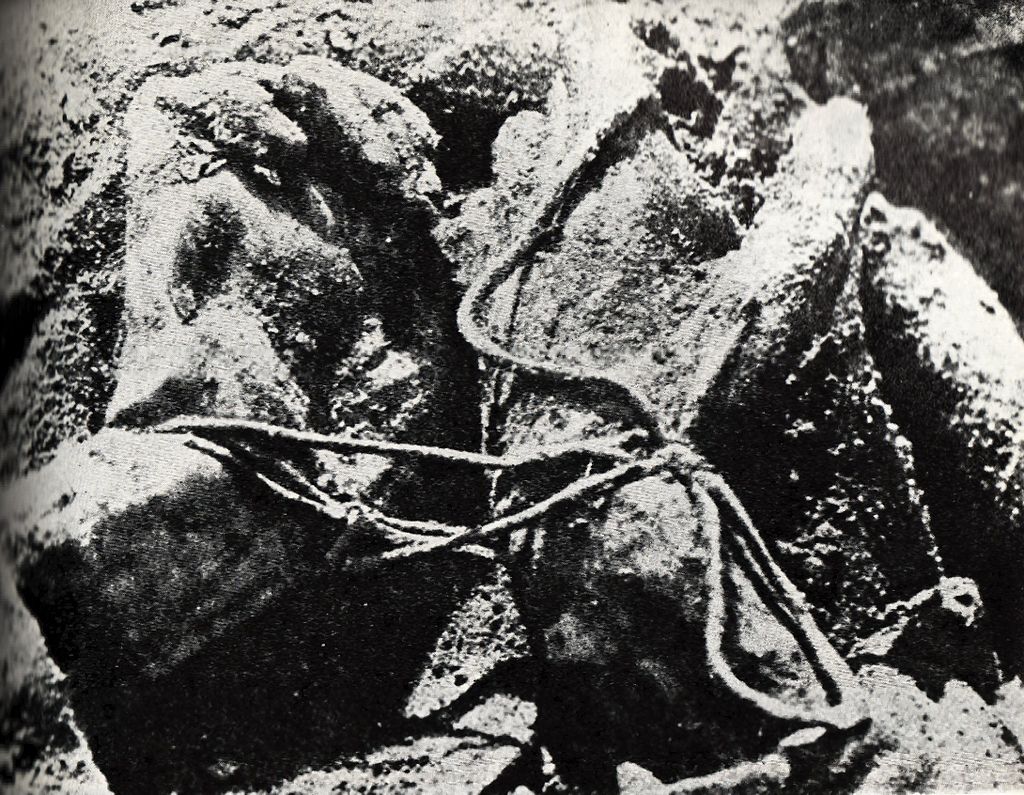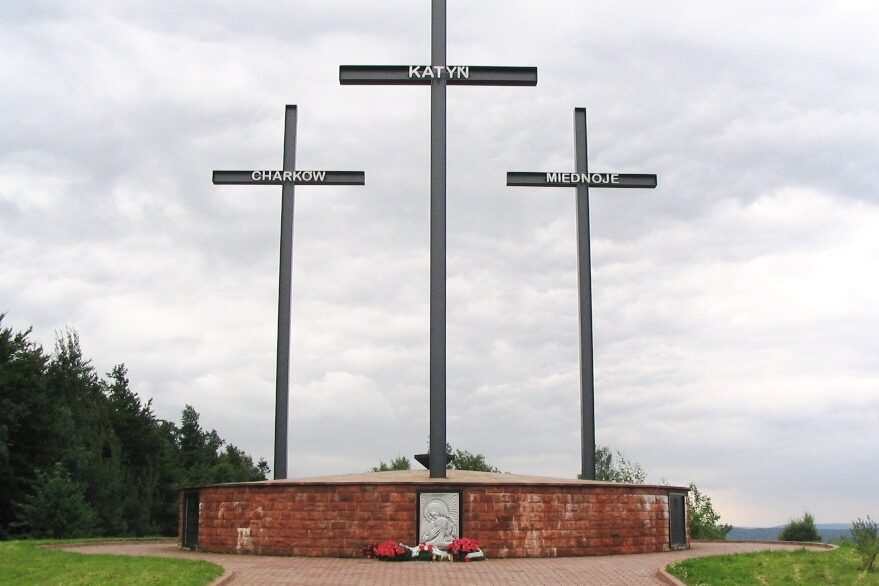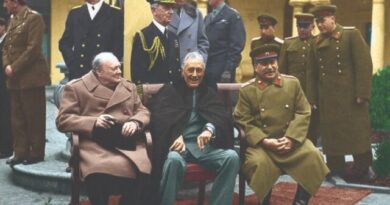Jewish victims of Katyń Massacre. The Soviets killed everybody in a Polish uniform

There were many Jews among those murdered in Katyń. One of them was the Chief Rabbi of the Polish Army.
Marek Gałęzowski
During the battle of Wołomin, which was one of many as part of the well-known Battle of Warsaw, when the armoured train „Paderewski” „started to move backwards toward Wołomin railway station and would definitely derail […]. Second Lieutenant Schrage, paying no attention to heavy fire opened by the enemy in the direction of the railway section dividing the two armoured vehicles, ran towards the approaching »Paderewski« and just in time warned the engine driver about danger. Thanks to the courage of the Second Lieutenant Schrage, »Paderewski« avoided crashing. In addition, throughout the period of being assigned as a member of the crew of the arm[oured] train »Mściciel«, Second Lieutenant Schrage showed great initiative, courage and presence of mind in the battles of: Grodno on 21 July 1920, Białystok on 27 July 1920, Łapy on 30 July 1920, Ostrołęka on 4 August 1920, and Zamość on 30 August 1920”. This is how the participation of Ignacy Schrage, Polish Jew, in the war against Bolsheviks, whose winning saved independence of the reborn Poland, was described in a request for granting the War Order of Virtuti Militari – Poland’s highest military decoration – to Shragge. Twenty years later, like many other participants of that war, Schrage, as the major of the Polish Army, was murdered by NKVD in Kharkov. He died together with thousands of his comrades on the basis of the criminal decision issued by the highest authorities of the Soviet Union on 5 March 1940, according to which the Polish POWs imprisoned in the camps of Kozielsk, Starobielsk and Ostaszków, and many others who were kept in Soviet prisons in Minsk and Kiev, were murdered.
„Gray Kite”
No one knows the origins of the pseudonym “Grey Kite” adopted by a Jewish high school student from Lviv, who, as a 14-years-old teenager, became the participant of a scouting team acting for country’s independence and shortly before the outbreak of World War I, joined the Riflemen’s Association. What we know is that he wanted to fight for Polish independence, and followed the trail of the Polish Legions in his gray uniform worn by the riflemen. In the bloody battle of Jastków, in which the 3rd Brigade took part in the summer of 1915, both his legs and one arm were wounded. He returned to service only many months later, having undergone five operations.
When the Odyssey of Marshall Pilsudski’s Legions ended up with an oath crisis, he began to work for a secret Polish Military Organization, and after disarming the Germans in November 1918, he joined the revived Polish Army. Appointed to the rank of an officer, after his above-mentioned, notable participation in the war against the Bolsheviks, he became the commander of the armoured train “Piłsudczyk,” and during the period when the Polish Army entered the Upper Silesia, he commanded the armoured train “Piast”. After the end of wars for Polish borders he served in the artillery. The reviews of his service were very positive; for example: “Sustainable and reliable character. Dedicated to service. […] Served as an example of diligence to his subordinates. Very intelligent […] and v[ery] brave officer. Great devotion. Honest, well-established character. Eager to serve. Extremely conscientious and diligent. […] Popular with his subordinates. Always in good mood”.

In 1934, he was a candidate of the Zionists for the position of the deputy mayor of Lviv but he lost to Wiktor Chajes, one of the leading supporters of assimilation in Lviv. Four years later he retired. He lived in Lviv and was present there in September 1939. He defended the city from the Germans as the first staff officer of the artillery command in the defence of Lviv. According to reports, he acted with high energy and very effectively on the post he was assigned to.
Lieutenant Colonel Maksymilian Landau was the commander of artillery defending Lviv and the direct superior of major Schrage. Like Schrage, that officer of artillery of the Polish Legions came from Lviv, and like Schrage, he became a Bolshevik war hero. In the request for granting to him the War Order of Virtuti Militari, we read that during the continuing counterattack of the Polish forces at Berezyna in May 1920, „in the operation of repelling the night attack, Major Landau, commander of group artillery [the operating group of Lieutenant Colonel Kazimierz Topoliński – annotation by M.G.], showed extreme bravery. Under attack and heavy fire from the enemy he climbed up the observation post surrounded from three sides and being under constant fire to control the activity and effectiveness of his artillery’s fire. Major Landau had multiple achievements during the campaign at Berezyna, where he commanded the fire of his batteries – in the battles of Sokółki, Malinówka, Karolina, Ulesie, and Lipsk. In the offensive fight – he was always ahead, at the advance group, and in retreat – he was always the last”.
He also belonged to the eminent officers of the Polish Army in the interwar period. As a result of his high rating, in 1928, he took command over the manoeuvring regiment of artillery (later transformed into 31. Light Artillery Regiment). On that position, he demonstrated „outstanding organizational skills. He organized the structure of the regiment and ensured its operation on a high level in terms of organization and training. This officer has remarkable managerial and pedagogic skills. Outstanding independence.”- we read in one of the opinions. In June 1934, he retired and became the director of the well-known Warsaw Gymnasium of Edward Rontaler. During the war with Germany, as the commander of artillery defending Lviv, he was in charge of the shootout that preceded the Polish attack on the German positions on Mount Kortumowa and the foreground of Cemetery Janowski, which took place on 16 September 1939. After the surrender of the city to the Red Army, he was transported to Starobielsk.
Historian’s brother
The third hero of this story was a student of the First Real School in Lviv, and like the slightly older Schrage, he was an active scout. In September 1916, being barely 16-years-old, he joined the Legions and was assigned to the famous Cavalry Regiment commanded by Colonel Władysław Belina-Prażmowski. However, he was not supposed to smell the gunpowder until 1 November 1918, during the fighting against the Ukrainians in the defence of Lviv started. Tadeusz Vorzimmer, because he is the person we talk about, was a member of the so-called first crew of defenders of Lviv also referred to as the Semper Fidelis City (Always Faithful). The crew counted only 142 people. He fought at the Central Station, in Wólka, in the defence of the 4th Section, but his most important contribution was the participation in the forming of Lviv artillery, together with his brothers Tadeusz and Julian Filipowicz (Julian, as a colonel of the Polish Army, will command the Volhynian Cavalry Brigade in September 1939, among others, in a famous battle of Mokra). Tadeusz was soon appointed to the rank of an officer, and was wounded in the war against the Bolsheviks. According to the opinion of Colonel Tadeusz Filipowicz, “he showed great sense of patriotism, outstanding courage and dedication. For me, he was one of the best officers of the squadron, which I commanded”.
In 1923, Tadeusz Vorzimmer, along with his half-brother, Henryk, who was one of the most outstanding Polish historians after the war, changed his name to Wereszycki after the name of the Wereszyca river, where they fought against the Bolsheviks. In free Poland, Tadeusz graduated from the Faculty of Mechanical Engineering of the University of Technology in Lviv and received the engineer’s degree. He took a job in the power plant in Lviv, but already two years later he founded his own private electromechanical plant. He was drafted towards the end of August 1939. As the reserve captain of the armament service, he was taken captive by the Soviets and, like the aforesaid officers, sent to Starobielsk. His wife Krystyna Amelia, lawyer, stayed together with their sons – Andrew, who was born in 1935 and John – born four years later – in the area under the German occupation. They were all murdered by the Germans, probably in 1942 in Nowy Sącz.
Henry Wereszycki, a Legion soldier and officer of the Polish Army, learned about the fate of his brother, his wife and children when he returned from German captivity to which he was taken after the last battle of the Polish war in 1939 near Kock.
Chief Rabbi
In the spring of 1940, among the thousands of Polish Army officers murdered by the NKVD there was a considerable number of Jews. The most frequently mentioned person is probably the chief rabbi of the Polish Army, namely, Major Baruch Steinberg. He had an impressive resume as far as fighting for independence is concerned. In autumn of 1918, as a 21-years-old rabbinical assessor, he joined the Polish underground forces fighting for independence in Przemyślany, which was under the authority of the Ukrainians after the collapse of the Austro-Hungarian Empire. Until the city was seized by the Polish Army in late spring 1919, Steinberg conducted successful intelligence activity. In later years, before becoming a chief rabbi of the Polish Army, he served, among others, as the head of pastoral care of the Jewish faith in the Third Corps Region of the Polish Army in Grodno. When remembering the Jews – Polish Army officers murdered in the spring of 1940 in the East – one must not forget that apart from professional officers, most of them were lawyers and doctors, usually soldiers of the 1920 war (or sometimes participants of battles for independence conducted in previous years), and later taking part in Poland’s defence against the Germans in September 1939.

While the fate and the burial sites of the said officers murdered in the inhuman land, are known, we should also mention those about whom we only know that they were arrested after 17 September 1939 by the Soviets, but their fate still remains unknown. These include officers of the Polish Legions: Henry Goldman and Leopold Spira, arrested by the NKVD in the area incorporated into the Ukrainian Soviet Republic and imprisoned in Lviv. There, the track is cut off, as they are not included in the so-called Ukrainian list of Polish citizens murdered by the NKVD in 1940.
They also served Poland well. At the end of October 1918, Goldman participated in the operation of depriving the Austrians of power in Kielce, and then, in the creation of the administrative service and the procurement department of the Polish Army, within the framework of which he organized supplies for the newly established troops. As the head of the procurement department of the 4th Army, he received praise for faultless performance of his duties from General Leonard Skierski, one of the Polish generals, who was murdered in Kharkov in 1940. During the retreat of the Polish Army from Baranowicze “Lieutenant Colonel Goldman, who remained on his post until the departure of the last transport, showed unbelievable courage, because the approaching enemy assisted by local gangs of Bolsheviks exerted increasing pressure. Having driven back the patrols that opened fire in his direction, Lieutenant Colonel Goldman, while risking his life, departed with the last transport, already under fire of the regular forces of the enemy “- so reads the request for granting the Cross of Valour to him. After leaving the military service, he studied French at the College of Army Procurement and Administration, and later, he worked for the National Economy Bank in Warsaw.
Leopold Spira, the hero of the Carpathian campaign of the 2nd Brigade of the Legions, for which he was awarded with the War Order of Virtuti Military in the independent Poland, served as the head of the department in the office of the minister of military affairs and the Aide Corps of the Commander-in-Chief of the Polish Army during the war with the Bolsheviks. His service was highly appreciated by General Kazimierz Sosnkowski. In the 1930s he was the director of the Municipal Marketplace Funding Institution (Miejska Kasa Targowa) in Cracow, but above all, he was one of the leading activists of the Association of Jews Participating in Fights for Independence of Poland.
When assessing the attitudes of Polish Jews after September 1939 in the areas occupied by the Red Army and incorporated into the Soviet empire, one too readily adopts stereotypical assumption that they commonly collaborated with the occupier and does not give a second thought to the fact that the communist apparatus of repression, when carrying out the criminal operation of annihilation of the elite class living in the eastern region of the Republic of Poland, did it irrespective of the nationality of the victims. Although among the victims of the crimes committed by the Communists there were mostly Poles, many of the murdered Polish citizens had a different nationality. Among them, there were also Jews murdered in many places of torture in revenge for having participated once in the struggle for Polish independence, and in the wars for borders of the reborn Poland, and for their diligent performance of public service in the independent Polish state.
The author has a Ph.D. degree (doctor habilitatus), and is the Deputy Director of the National Education Office in the Institute of National Remembrance, as well as a professor at the Łazarski University.



